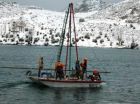(Press-News.org) The doors are open on NASA's Suomi NPP satellite and the newest version of the Clouds and the Earth's Radiant Energy System (CERES) instrument is scanning Earth for the first time, helping to assure continued availability of measurements of the energy leaving the Earth-atmosphere system.
The CERES results help scientists to determine the Earth's energy balance, providing a long-term record of this crucial environmental parameter that will be consistent with those of its predecessors.
CERES arrived in space Oct. 28, 2011, carried by NASA's newest Earth-observing satellite, the recently renamed Suomi National Polar-orbiting Partnership, or Suomi NPP. Suomi NPP is the result of a partnership between NASA, NOAA and the Department of Defense.
Instrument cover-opening activities began on the instrument at 10:12 a.m. Eastern time Jan. 26, an operation that took about three hours. The "first light" process represented the transition from engineering checkout to science observations. The next morning CERES began taking Earth-viewing data, and on Jan. 29 scientists produced an image from the scans.
"It's extremely gratifying to see the CERES FM-5 instruments on Suomi NPP begin taking measurements. We're continuing the legacy of the most accurate Earth radiation budget observations ever made," said CERES project scientist Kory Priestley, of NASA's Langley Research Center in Hampton, Va.
"It has taken an incredible team of engineers, scientists, data management and programmatic experts to get CERES to this point," he said.
NASA instruments have provided the scientific community unprecedented observations of the Earth's climate and energy balance for nearly 30 years. The first CERES instrument was launched in 1997. Before that, the Earth Radiation Budget Experiment (ERBE) did the job beginning in 1984.
Langley Research Center has led both the ERBE and CERES experiments and provided stewardship of these critical climate observations.
For 27 years without a break, the instruments collectively have returned a vast quantity of precise data about the solar energy reflected and absorbed by Earth, the heat the planet emits, and the role of clouds in that process.
"CERES monitors minute changes in the Earth's energy budget, the difference between incoming and outgoing energy," said CERES principal investigator Norman Loeb, of Langley Research Center.
"Any imbalance in Earth's energy budget due to increasing concentrations of heat trapping gases warms the ocean, raises sea level, and causes increases in atmospheric temperature," Loeb said. "Amassing a long record of data is important in order to understand how Earth's climate is changing in response to human activities as well as natural processes."
How It Works
In addition to observing changes in Earth's radiation budget, scientists are also monitoring changes in clouds and aerosols, which strongly influence Earth's radiation budget.
"Clouds both reflect sunlight and block energy from radiating to space," Loeb said. "Which of these two effects dominates depends upon the properties of clouds, such as their amount, thickness and height."
"As the Earth's environment evolves, cloud properties may change in ways that could amplify or offset climate change driven by other processes. Understanding the influence of clouds on the energy budget is therefore a critical climate problem."
The four other CERES instruments are in orbit on NASA's Aqua and Terra satellites.
Overall Mission
The five-instrument suite on Suomi NPP collects and distributes remotely sensed land, ocean, and atmospheric data to the meteorological and global Earth system science research communities. The mission will provide atmospheric and sea surface temperatures, humidity sounding, land and ocean biological productivity, cloud and aerosol properties, total/profile ozone measurements, and monitor changes in the Earth's radiation budget.
INFORMATION:
NASA's Goddard Space Flight Center in Greenbelt, Md., manages the Suomi mission for the Earth Science Division of the Science Mission Directorate at NASA Headquarters in Washington. The National Oceanic and Atmospheric Administration's Joint Polar Satellite System (JPSS) program provides the satellite ground system and NOAA provides operational support. Suomi NPP commissioning activities are expected to be completed by March.
NASA Langley manages the CERES experiment with additional contracted support from Science Systems and Applications, Inc. The TRW Space & Electronics Group in Redondo Beach, Calif., now owned by Northrop Grumman Aerospace Systems, built all of the CERES instruments.
'First light' taken by NASA's newest CERES instrument
2012-02-06
ELSE PRESS RELEASES FROM THIS DATE:
NASA satellites see wind shear battering Tropical Depression Iggy
2012-02-06
NASA satellites have watched as wind shear has torn Cyclone Iggy apart over the last day. NASA infrared satellite imagery showed that Iggy's strongest thunderstorms have been pushed away from the storm's center and visible imagery shows the storm is being stretched out. Iggy is weakening and heading for a landfall between Geraldton and Perth.
When NASA's Aqua satellite passed over Tropical Cyclone Iggy on Feb. 1 at 1805 UTC (1:05 p.m. EST), the Atmospheric Infrared Sounder (AIRS) instrument aboard captured an infrared look at the cyclone. AIRS data showed that the strongest ...
A battle of the vampires, 20 million years ago?
2012-02-06
CORVALLIS, Ore. – They are tiny, ugly, disease-carrying little blood-suckers that most people have never seen or heard of, but a new discovery in a one-of-a-kind fossil shows that "bat flies" have been doing their noxious business with bats for at least 20 million years.
For bats, that's a long time to deal with a parasite doing its best vampire impression. Maybe it is nature's revenge on the vampire bat, an aggressive blood consumer in its own right that will feed on anything from sheep to dogs and humans.
The find was made by researchers from Oregon State University ...
Breastfeeding and lung function at school age: Does maternal asthma modify the effect?
2012-02-06
Breastfeeding is associated with improved lung function at school age, particularly in children of asthmatic mothers, according to a new study from researchers in Switzerland and the UK.
"In our cohort of school age children, breastfeeding was associated with modest improvement in forced mid-expiratory flow (FEF50) in our whole group and with improvements in forced vital capacity (FVC) and forced expiratory volume at 1 second (FEV1) only in the children of asthmatic mothers," said Claudia E. Kuehni, MD, MSc, professor at the Institute of Social and Preventive Medicine ...
Classic portrait of a barred spiral galaxy
2012-02-06
Most spiral galaxies in the Universe have a bar structure in their centre, and Hubble's image of NGC 1073 offers a particularly clear view of one of these. Galaxies' star-filled bars are thought to emerge as gravitational density waves funnel gas toward the galactic centre, supplying the material to create new stars. The transport of gas can also feed the supermassive black holes that lurk in the centres of almost every galaxy.
Some astronomers have suggested that the formation of a central bar-like structure might signal a spiral galaxy's passage from intense star-formation ...
New procedure repairs severed nerves in minutes, restoring limb use in days or weeks
2012-02-06
American scientists believe a new procedure to repair severed nerves could result in patients recovering in days or weeks, rather than months or years. The team used a cellular mechanism similar to that used by many invertebrates to repair damage to nerve axons. Their results are published today in the Journal of Neuroscience Research.
"We have developed a procedure which can repair severed nerves within minutes so that the behavior they control can be partially restored within days and often largely restored within two to four weeks," said Professor George Bittner from ...
New technique dissolves blood clots in the brain and lowers risk of brain damage after stroke
2012-02-06
Johns Hopkins neurologists report success with a new means of getting rid of potentially lethal blood clots in the brain safely without cutting through easily damaged brain tissue or removing large pieces of skull. The minimally invasive treatment, they report, increased the number of patients with intracerebral hemorrhage (ICH) who could function independently by 10 to 15 percent six months following the procedure.
At the International Stroke Conference taking place January 31 through February 2 in New Orleans, the researchers will present their findings from 93 patients, ...
New technology to tackle treatment-resistant cancers
2012-02-06
Free-flowing cancer cells have been mapped with unprecedented accuracy in the bloodstream of patients with prostate, breast and pancreatic cancer, using a brand new approach, in an attempt to assess and control the disease as it spreads in real time through the body, and solve the problem of predicting response and resistance to therapies.
In comparison to a previous generation of systems, the researchers state their test showed a significantly greater number of high-definition circulating tumour cells (HD-CTCs), in a higher proportion of patients, by using a computing-intensive ...
NYU Courant researchers weigh methods to more accurately measure genome sequencing
2012-02-06
Lost in the euphoria of the 2003 announcement that the human genome had been sequenced was a fundamental question: how can we be sure that an individual's genome has been read correctly?
While the first full, individual genome was sequenced a decade ago, given the vast genetic variation across the world's seven billion people, not to mention the differences in makeup even among close relatives, the question of accurate sequencing for individuals has continued to vex researchers.
With companies now projecting they can sequence a genome for a $1,000, down from $25,000 ...
Parasites or not? Transposable elements in fruit flies
2012-02-06
Nearly all organisms contain pieces of DNA that do not really belong to them. These "transposable elements", so called because they are capable of moving around within and between genomes, generally represent a drain on the host's resources and in certain cases may lead directly to disease, e.g. when they insert themselves within an essential host gene. The factors that govern the spread of transposable elements within a population are broadly understood but many of the finer points remain unclear. New work at the University of Veterinary Medicine, Vienna (Vetmeduni ...
Sediments from the Enol lake reveal more than 13,500 years of environmental history
2012-02-06
A team of Spanish researchers have used different geological samples, extracted from the Enol lake in Asturias, to show that the Holocene, a period that started 11,600 years ago, did not have a climate as stable as was believed.
The Holocene period, which includes the last 11,600 years of our history, has always been described as a stable period in terms of climatic conditions, especially when compared to the abrupt changes that occurred in the last ice age, which ended around 10,000 years ago, giving way to the Holocene.
A study carried out by researchers from the Pyrenean ...



